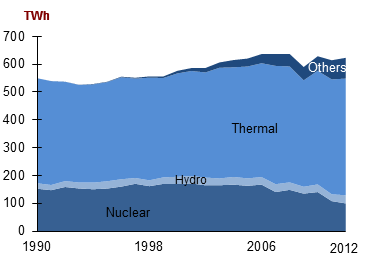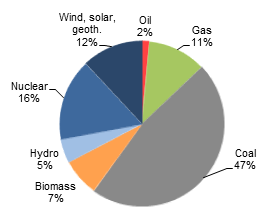Increasing power generation in Germany despite nuclear shutdown
2012 Key Figures
Population: 81.7 million
GDP growth rate: 0.9%
Energy independence: 41%
Total consumption/GDP: 83.8 (2005=100)
CO2 Emissions: 9.0 tCO2/capita
Extract on Power generation in Germany
In 2012, electricity production increased slightly by 1.4%, to 623 TWh, which correspond to 2005 production level, i.e. 14 TWh lower than its peak (2008). Solid fuels (coal and lignite) are the main source of energy for the production of electricity, accounting for 47% of the electricity produced. Following the regular decrease in the share of solid fuels in the electricity mix from 2000 (53%) until 2010 (43%), its share is rising again to offset the reduction of the power produced by the nine nuclear units closed in 2011.
Nuclear ranks second with 16% while the contribution of gas fell to 11% (14% in 2011). Wind production reached 43.7 TWh in 2012 (7% of overall electricity generation), compared to 9 TWh in 2000.
Gross Power Production by Source (TWh)

Power Generation by Source (2012, %)

Power interconnections/exchanges
Germany remained a net exporter of electricity in 2012, despite nuclear power plant shut-downs. In 2012, Germany imported 45.3 TWh of electricity, mainly from France (30%), Denmark and the Czech Republic (19% each), and exported 65 TWh mainly toward the Netherlands (34%), Austria (22%) and Switzerland (19%). The export surplus was six times higher than in 2011 and significantly higher than surplus recorded in 2010 and 2009.
More information about the Germany energy market
 Energy and Climate Databases
Energy and Climate Databases Market Analysis
Market Analysis